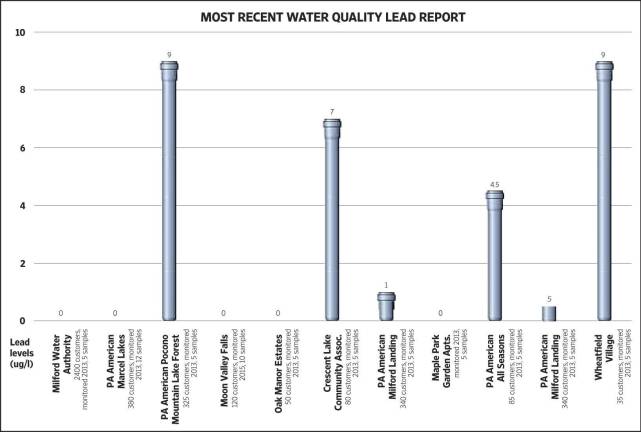How much lead is in your water?


By Erika Norton
News of toxic lead in the Flint, Michigan, public water system brought with it an increased understanding: lead is still very much with us, no matter where in the country you live.
“In relation to everything that’s going on in Flint, there’s a new awareness,” said Kelly Love, administrator for the West Milford Municipal Utilities Authority in New Jersey.
The U.S. Environmental Protection Agency (EPA) requires all community water systems to file a water quality report, called a Consumer Confidence Report (CCR), for their customers by July 1 each year. These reports are supposed to allow consumers to make educated decisions about the quality of their drinking water. The substances tested for include microbiological contaminants like E. coli, radioactive contaminants, synthetic organic contaminants like pesticides and herbicides, volatile organic contaminants found in discharge from chemical factories, and inorganic contaminants like copper, mercury, and lead. In Pennsylvania, these results must be posted on the Pennsylvania Department of Environmental Protection website.
The highest lead level was found in the Pennsylvania American Water Pocono Mountain Lake Forest Line in Dingmans Ferry, with 9 ug/L, which is still relatively low. The lowest levels, 0 ug/L, were found in the systems managed by the Milford Water Authority, Pennsylvania American Water Marecel Lakes, Moon Valley Falls, Oak Manor Estates, and Maple Park Garden Apartments.
The two main ways lead gets into water, according to CCR, is through corroded household plumbing systems and from eroded natural deposits. Milford hasn’t had a problem with elevated lead levels in recent years, according to Timothy Gartner, superintendent and licensed operator of the Milford Water Authority.
“We’ve been on corrosion control since 1999, when the treatment plant was built here,” Gartner said. “And since then, we’ve replaced 98 percent of our water main system, which took out any of the lead goosenecks that were used in the 1940s and in 1920s when they installed the first water system. So most of the lead has been removed from the system at this time."
The Milford Water Authority also runs a corrosion control program to maintain pH at a neutral level, so that household plumbing materials do not leach into the water. Lead and copper are tested, as required by the state, at least every three years. The Milford Water Authority came back with a clean bill of health.
According to the EPA, houses built before 1986 are more likely to have lead pipes, fixtures, and solder. Although Milford still has a lot of older homes, Gartner said, many have updated, plastic piping in their plumbing systems.
“Still, there are a lot of 200-year-old homes, 150-year-old homes in town, so there’s still the potential for that problem to be in the old plumbing as to what they used for fixtures and soldering in the joints and stuff like that,” he said.
The Milford Water Authority isn't responsible for household plumbing but does everything possible from their end to keep water pure, Gartner said.
The DEP recommends that private well owners test their well water annually for total coliform bacteria, nitrates, total dissolved solids such as lead and copper, and pH levels. Only state-certified labs should test drinking water tests. Some testing can be expensive.
The DEP recommends that well owners set a regular maintenance schedule and keep accurate, up-to-date records. They should conduct monthly checks of the visible parts of their systems, looking for cracks and corrosion, broken or missing well caps, or cracked surface seals.
A change in the color, taste or smell of water can also indicate a potential problem.
Lead can over time also accumulate in our bodies, where it is stored in bones, along with calcium. During pregnancy, lead is released from bones as maternal calcium and is used to help form the bones of the fetus, especially in women with insufficient calcium in their diet.
Lead can also cross the placental barrier, according to the EPA. This can result in serious health problems for both the mother and her developing fetus. Adults who drink lead-tainted water over many years may develop kidney problems or high blood pressure.
The Centers for Disease Control and Prevention, along with the health departments of individual states, collect blood from children under three. In many states, including Pennsylvania, pediatricians are required to test all children, ages one and two, whose families receive Medicaid.
In some states, such as New York and New Jersey, all children ages one and two must be tested. More than 10 ug/dL of lead in their blood is an elevated level.
According to the CDC, Pennsylvania had the second-highest percentage of children under three with an elevated blood lead level in 2014, with 1.28 percent statewide. New York State, excluding New York City, topped Pennsylvania, with 1.46 percent statewide.
Only 0.6 percent of the children tested had an elevated blood lead level in Pike County in 2014, with the highest tristate levels in Warren and Blair counties in New Jersey
Emrick Seabold, the acting administrator and health officer for the Sussex County Environmental and Public Health Services in New Jersey, investigates high childhood lead levels, to come up with the source of the toxin. Sometimes it's the water, but sometimes it's something else in the environment.
“The older houses, not only do they have this lead piping bringing the water to the house, but a lot of the older houses had lead paint and many people have done renovations in the house and that’s another potential avenue to expose children to leaded paint and raise their blood lead,” Seabold said.
He also said that some children have pica, a disorder characterized by an appetite for non-food items, like paint chips.
“Keep your children away from home improvement projects, especially where you’re going to be sanding or scraping paint, or power washing the outside of your home," said Seabold. "Many times that brings down paint chips onto the soil. And then kids play in that area, and they pick them up and ingest them."
The Pennsylvania Department of Health also has a list of tips. One recommends using only cold tap water to prepare formula and for drinking and cooking. Water that comes out of the tap warm or hot can contain much higher levels of lead, and boiling water will not reduce the amount.
For more information on lead in drinking water, contact the PADEP Lead Information Line at 1-800-440-LEAD or the EPA Safe Drinking Water Hotline at 1-800-426-4791.